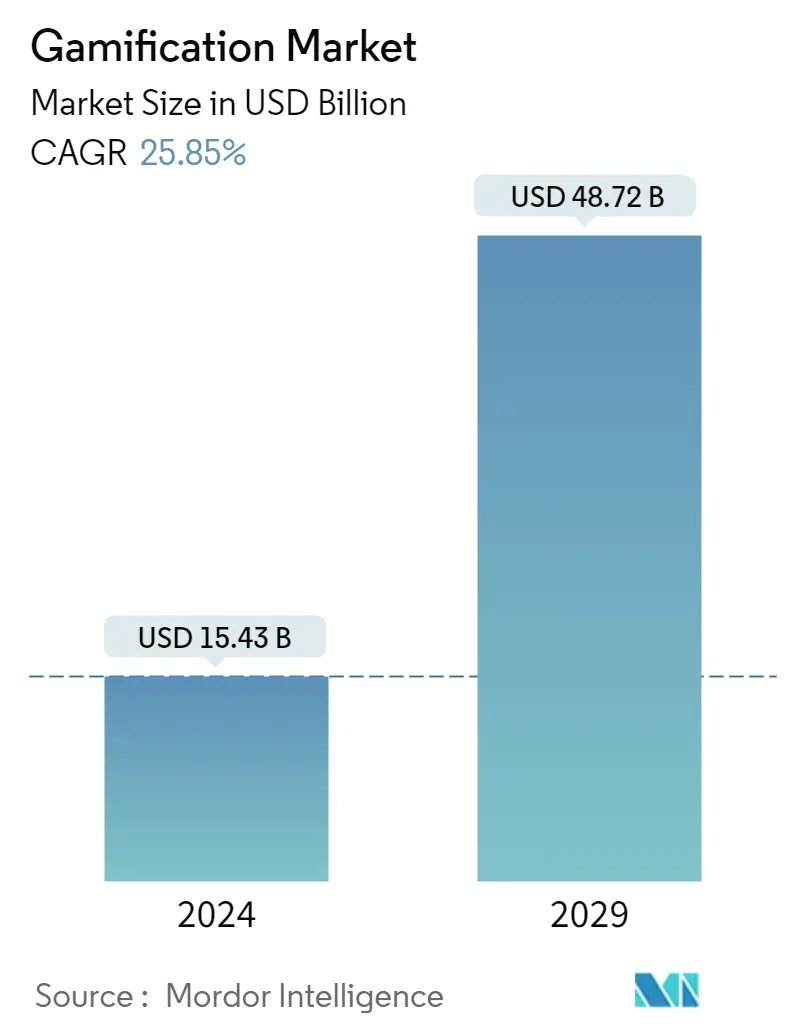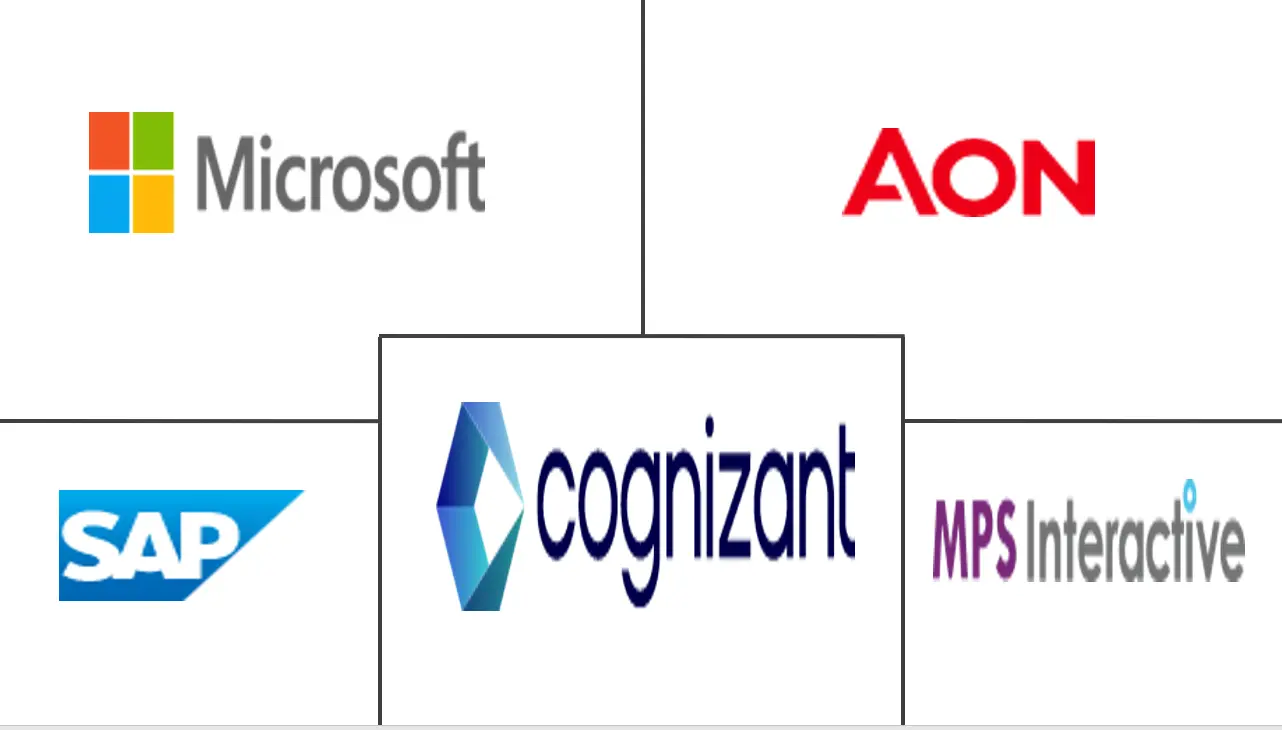Market Size of Gamification Industry

| Study Period | 2019 - 2029 |
| Market Size (2024) | USD 15.43 Billion |
| Market Size (2029) | USD 48.72 Billion |
| CAGR (2024 - 2029) | 25.85 % |
| Fastest Growing Market | Asia Pacific |
| Largest Market | North America |
Major Players
*Disclaimer: Major Players sorted in no particular order |
Gamification Market Analysis
The Gamification Market size is estimated at USD 15.43 billion in 2024, and is expected to reach USD 48.72 billion by 2029, growing at a CAGR of 25.85% during the forecast period (2024-2029).
The exponential growth in smartphones and mobile devices directly created a vast base for the gamification market. The increasing recognition of gamification systems also supports this growth as a method to architect human behavior to induce innovation, productivity, or engagement.
- The increasing popularity of smartphones has greatly broadened the possibilities for gamification. The migration of customers and staff from desktop computers to mobile phones and internet devices provides a lucrative platform for banks to grab consumer interest with a higher likelihood of conversion and usage.
- Furthermore, connections with social networking sites have enabled users to share their experiences with friends, acquaintances, and coworkers, extending the platform's reach and efficacy. Another benefit is that mobile applications allow marketers to send out surveys, even if they are only one question long, allowing them to collect firsthand data from their target audience members and tailor their efforts accordingly. Recent MIT research, for example, found that agile organizations experience faster revenue growth and 30% higher profitability than non-agile organizations.
- According to a study on the use of gamification in businesses, it is frequently done in the most generic ways. They employ point systems, leaderboards, and badges in any process rather than designing experiences that balance competition and collaboration. This omission in developing the meaning of this method is expected to result in 80% of the efforts in companies that have used it.
- Furthermore, the adoption of advanced technologies such as AI and ML is expected to gain traction in the coming years, with vendors and enterprises focusing on developing solutions that learn and become more intuitive and effective over time. Vendor investment in the technology is expected to increase in the coming years.
- The gaming industry saw a global spike in mobile game demand since the COVID-19 outbreak, and the statewide shutdown impacted several companies. Smartphone users downloaded various games and other apps during the recent statewide lockdowns imposed nationwide. The Russia-Ukraine conflict also influenced the wider packaging ecosystem.
Gamification Industry Segmentation
Gamification uses the human tendency to influence one's thinking process by engaging users to become effective problem solvers, even in the real world. Gamification has proven its benefits in different activities, such as customer experience enrichment, employee engagement, and providing rewards to people.
The market studies the deployment type, such as on-cloud and on-premise, along with the organization's size, platform, end-user vertical, and geographical analysis throughout the forecast period. For the study, various factors such as consumer spending, consumer preference trends, the impact of COVID-19, and other macroeconomic factors are considered to arrive at the overall market projections.
The gamification market is segmented by deployment (on-premise, on-cloud), size (small and medium enterprises, large enterprises, platform (open platform, closed/ enterprise platform), end-user vertical (retail, banking, government, healthcare, education and research, IT and telecom), geography (North America, Europe, Asia-Pacific, Latin America, Middle East and Africa). The market sizes and forecasts are provided in terms of value (USD) for all the above segments.
| By Deployment | |
| On-premise | |
| On-cloud |
| By Size | |
| Small and Medium Enterprises | |
| Large Enterprises |
| By Platform | |
| Open Platform | |
| Closed/ Enterprise Platform |
| By End-user Vertical | |
| Retail | |
| Banking | |
| Government | |
| Healthcare | |
| Education and Research | |
| IT and Telecom | |
| Other End-user Verticals |
| By Geography | |
| North America | |
| Europe | |
| Asia-Pacific | |
| Latin America | |
| Middle East and Africa |
Gamification Market Size Summary
The gamification market is experiencing significant growth, driven by the proliferation of smartphones and mobile devices, which have created a vast user base for gamification applications. This growth is further supported by the increasing recognition of gamification as a tool to enhance innovation, productivity, and engagement. The shift from desktop to mobile platforms has opened new avenues for businesses, particularly in sectors like banking, to engage consumers more effectively. The integration of social networking sites has also expanded the reach of gamification, allowing users to share their experiences and providing marketers with valuable insights through mobile surveys. The adoption of advanced technologies such as artificial intelligence and machine learning is expected to enhance the effectiveness of gamification solutions, making them more intuitive and impactful over time.
In the retail industry, gamification is emerging as a powerful strategy to enhance customer engagement and drive sales. By incorporating gamification techniques, retailers can create interactive and rewarding experiences that resonate with consumers, particularly younger demographics like Gen Z. This approach not only fosters brand loyalty but also encourages repeat purchases and customer retention. The North American market, with its high internet and smartphone penetration, is a key region for gamification, with numerous companies leveraging these strategies to boost engagement and profitability. Major players in the market are focusing on expanding their global presence and enhancing their offerings through strategic partnerships and technological advancements, further solidifying gamification's role as a critical component in modern marketing and customer engagement strategies.
Gamification Market Size - Table of Contents
-
1. MARKET INSIGHTS
-
1.1 Market Overview
-
1.2 Industry Attractiveness Porter's Five Forces Analysis
-
1.2.1 Bargaining Power of Buyers/Consumers
-
1.2.2 Bargaining Power of Suppliers
-
1.2.3 Threat of New Entrants
-
1.2.4 Threat of Substitute Products
-
1.2.5 Intensity of Competitive Rivalry
-
-
1.3 Assessment of COVID-19 Impact on the Market
-
-
2. MARKET SEGMENTATION
-
2.1 By Deployment
-
2.1.1 On-premise
-
2.1.2 On-cloud
-
-
2.2 By Size
-
2.2.1 Small and Medium Enterprises
-
2.2.2 Large Enterprises
-
-
2.3 By Platform
-
2.3.1 Open Platform
-
2.3.2 Closed/ Enterprise Platform
-
-
2.4 By End-user Vertical
-
2.4.1 Retail
-
2.4.2 Banking
-
2.4.3 Government
-
2.4.4 Healthcare
-
2.4.5 Education and Research
-
2.4.6 IT and Telecom
-
2.4.7 Other End-user Verticals
-
-
2.5 By Geography
-
2.5.1 North America
-
2.5.2 Europe
-
2.5.3 Asia-Pacific
-
2.5.4 Latin America
-
2.5.5 Middle East and Africa
-
-
Gamification Market Size FAQs
How big is the Gamification Market?
The Gamification Market size is expected to reach USD 15.43 billion in 2024 and grow at a CAGR of 25.85% to reach USD 48.72 billion by 2029.
What is the current Gamification Market size?
In 2024, the Gamification Market size is expected to reach USD 15.43 billion.

